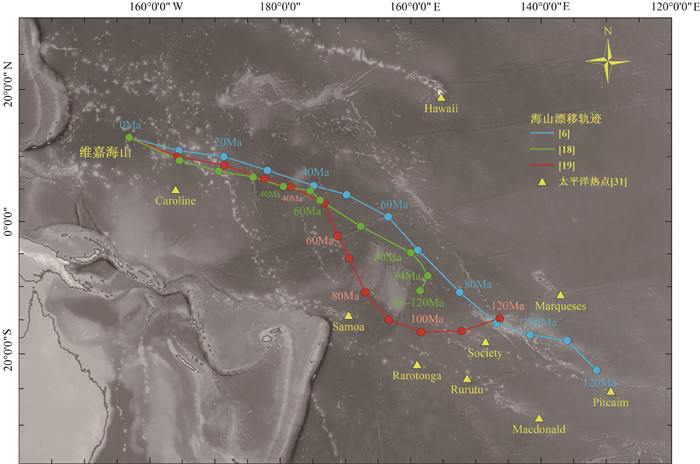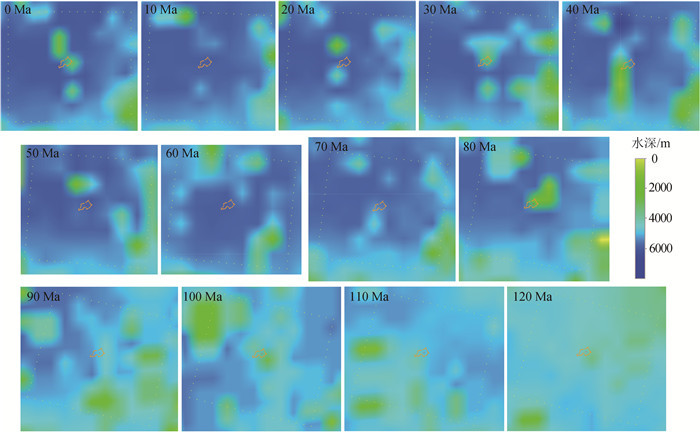Drift history and subsidence process of Weijia Guyot, China contract area of Co-rich crust
-
摘要:
应用全球板块构造-水深模型,对西太平洋中国富钴结壳合同区海山——维嘉海山的水平漂移轨迹和垂向沉降过程进行反演,获取海山各个历史时期的水深和古纬度信息,探讨海山演化过程中热点作用的影响。结果表明,维嘉海山最初形成于南太平洋同位素和热异常区,之后向NW向漂移约7500 km至现今位置。维嘉海山初始位置与其附近热点尚有一定的距离(约为200 km),随板块漂移过程中也未经过热点,与热点最近距离为150 km,结合海山现今的构造特征分析,推测热点作用并非形成海山的唯一成因,但在海山形成及漂移过程中为其打上"热点"烙印。
Abstract:Based on the global plate tectonic-bathymetric model, the horizontal drift track and vertical subsidence process of the Weijia Guyot, also known as the cobalt-rich nodule contract area of China in the Western Pacific Ocean, are inversed to obtain the palaeobathymetry and palaeolatitude of seamounts in different historical periods and to discuss the influence of hot spots in the evolution process of the seamount.The results show that the Weijia Guyot was formed initially in the isotopic anomaly and thermal anomaly area of South Pacific, and then drifted northeastward about 7500 km to the present position.There is a certain distance (about 200 km) between the initial location of the Weijia Guyot and its adjacent hot spots.The Weijia Guyot did not pass through these hot spots in the process of drift, and its closest distance to them is 150 km.Combined with the analysis of the present structure of the Weijia Guyot, it is speculated that these hot spots are not the only cause of the Weijia Guyot formation, but the Weijia Guyot was branded as "hot spots" in its formation and drift process.
-

-
图 1 麦哲伦海山区构造简图(据参考文献[2]修改)
Figure 1.
表 1 维嘉海山古位置及其古水深信息
Table 1. Information of paleolocation and palaeobathymetry of the Weijia Guyot
年龄/Ma Seton等[6] Müller等[19] Scotese等[18] 经度/° 纬度/° 距热点距离 经度/° 纬度/° 距热点距离 水深/m* 经度/° 纬度/° 距热点距离 水深/m 120 -131.48 -22.38 120 Ma距Pitcaim热点约215 km -146.31 -14.78 120 Ma距Society热点约235 km,
115 Ma时距Society热点约150 km5143 -158.52 -10.62 距Samoa热点约650 km;
距Rarotonga热点约630 km;
距Society热点约700 km4560 110 -136.02 -18.07 -152.16 -16.65 5244 -158.52 -10.62 4120 100 -141.65 -17.25 -158.42 -16.81 5318 -158.52 -10.62 4920 90 -146.81 -15.54 90 Ma距Society热点约180 km -163.36 -14.99 5375 -158.52 -10.62 5320 88 -147.66 -14.97 -164.16 -14.41 -158.52 -10.62 86 -148.40 -14.41 -164.83 -13.80 -158.10 -9.88 84 -149.15 -13.86 -165.49 -13.32 -157.35 -8.37 82 -150.68 -12.52 -166.22 -12.22 -158.45 -6.44 80 -152.45 -10.89 -166.98 -10.86 82 Ma距Samoa热点约235 km 5418 -159.99 -4.78 1360 70 -158.89 -4.38 -169.41 -5.63 5450 -167.65 -0.74 5240 60 -163.45 0.75 10 Ma距Caroline热点约320 km -171.20 -2.21 5473 -173.86 3.28 5920 50 -169.80 4.16 -173.19 2.90 5489 -175.38 4.75 6000 40 -174.84 5.57 -178.35 5.37 5499 -179.47 5.43 5594 30 178.07 7.91 177.62 6.65 5503 175.91 6.89 5880 20 171.38 10.01 171.46 8.67 5501 170.61 7.77 5880 10 164.51 10.90 164.30 10.01 10 Ma距Caroline热点约280 km 5492 164.63 9.42 10 Ma距Caroline热点约240 km 5800 0 156.87 12.88 156.87 12.88 5473 156.87 12.88 3000 注:*表示Müller等[19]的模型为构造重建模型,水深数据据参考文献[28],为海山所处洋盆位置的古水深 -
[1] 任向文. 西太平洋富钴结壳成矿系统[D]. 中国科学院海洋研究所博士学位论文, 2005: 64-67.
[2] Koppers A A P, Staudigel H, Pringle M S, et al. Short-lived and discontinuous intraplate volcanism in the South Pacific: Hot spots or extensional volcanism?[J]. Geochemistry Geophysics Geosystems, 2003, 4(10): 1-49. http://onlinelibrary.wiley.com/doi/10.1029/2003gc000533
[3] Staudigel H, Park K H, Pringle M, et al. The longevity of the South Pacific Isotope and Thermal Anomaly[J]. Earth and Planetary Science Letters, 1991, 102(1): 24-44. doi: 10.1016/0012-821X(91)90015-A
[4] Koppers A A P, Staudigel H, Christie D M, et al. Sr-Nd-Pb Isotope Geochemistry of Leg 144 West Pacific guyots: implications for the geochemical evolution of the 'SOPITA' mantle anomaly[C]//Haggerty JA, Premoli Silva I, Rack F, et al(Eds. ). Proc. ODP Leg 144, 1995: 535-545.
[5] Koppers A A P, Staudigel H, Wijbrans J R, et al. The Magellan seamount trail: implications for Cretaceous hotspot volcanism and absolute Pacific plate motion[J]. Earth and Planetary Science Letters, 1998, 163(1/4): 53-68. http://www.sciencedirect.com/science/article/pii/S0012821X98001757
[6] Seton M, Müller R D, Zahirovic S, et al. Global continental and ocean basin reconstructions since 200 Ma[J]. Earth Science Reviews, 2012, 113(3/4): 212-270. http://www.sciencedirect.com/science/article/pii/S0012825212000311
[7] Epp D. Possible perturbations to hotspot traces and implications for the origin and structure of the Line Islands[J]. Journal of Geophysical Research, 1984, 89(B13): 11273-11286. doi: 10.1029/JB089iB13p11273
[8] Lonsdale P. Geography and history of the Louisville hotspot chain in the Southwest Pacific[J]. Journal of Geophysical Research, 1988, 93(B4): 3078-3104. doi: 10.1029/JB093iB04p03078
[9] Wessel P, Kroenke L. A geometric technique for relocating hotspots and refining absolute plate motions[J]. Nature, 1997, 387: 365-369. doi: 10.1038/387365a0
[10] 何高文, 赵祖斌, 朱克超, 等. 西太平洋富钴结壳资源[M]. 北京: 地质出版社, 2001: 10-15.
[11] 李三忠, 余珊, 赵淑娟, 等. 超大陆与全球板块重建派别[J]. 海洋地质与第四纪地质, 2014, 34(6): 97-117. https://www.cnki.com.cn/Article/CJFDTOTAL-HYDZ201406013.htm
[12] Argus D F, Heflin M B. Plate motion and crustal deformation estimated with geodetic data from the Global Positioning System[J]. Geophysical Research Letters, 1995, 22(15): 1973-1976. doi: 10.1029/95GL02006
[13] Argus D F, Gordon R G, Heflin M B, et al. The angular velocities of the plates and the velocity of Earth's centre from space geodesy[J]. Geophysical Journal International, 2010, 180(3): 913-960. doi: 10.1111/j.1365-246X.2009.04463.x
[14] Demets C, Gordon R G, Argus D F. Geologically current plate motions[J]. Geophysical Journal International, 2010, 181(1): 1-80. doi: 10.1111/j.1365-246X.2009.04491.x
[15] Scotese C R. Jurassic and cretaceous plate tectonic reconstructions[J]. Palaeogeography, Palaeoclimatology, Palaeoecology, 1991, 87(1/4): 493-501. http://www.sciencedirect.com/science/article/pii/003101829190145H
[16] Müller R D, Sdrolias M, Gaina C, et al. Long-term sea level fluctuations driven by ocean basin dynamics[J]. Science, 2008, 319(5868): 1357-1362. doi: 10.1126/science.1151540
[17] Stadler G, Gurnis M, Burstedde C, et al. The dynamics of plate tectonics and mantle flow: From local to global scales[J]. Science, 2010, 329(5995): 1033-1038. doi: 10.1126/science.1191223
[18] Scotese C R, Wright N. PALEOMAP Paleodigital Elevation Models (PaleoDEMS) for the Phanerozoic PALEOMAP Project[M]. https://www.earthbyte.org/paleodem-resource-scotese-and-wright-2018.
[19] Müller R D, Seton M, Zahirovic S, et al. Ocean basin evolution and global-scale plate reorganization events since Pangeabreakup[J]. Annu. Rev. Earth Planet. Sci., 2016, 44(1): 107-138. doi: 10.1146/annurev-earth-060115-012211
[20] Piper J D A. A planetary perspective on Earth evolution: Lid Tectonics before Plate Tectonics[J]. Tectonophysics, 2013, 589: 44-56. doi: 10.1016/j.tecto.2012.12.042
[21] Boyden J A, Müller R D, Gurnis M, et al. Next-generation plate-tectonic recon structions using GPlates[C]//Keller G R, Baru C. Geoinformatics: Cyberinfrastructure for the Solid Earth Sciences. Cambridge, UK: Cambridge Univ. Press, 2011: 95-114.
[22] Cannon J, Lau E, Müller R D. Plate tectonic raster reconstruction in GPlates[J]. Solid Earth, 2014, 5(2): 741-755. doi: 10.5194/se-5-741-2014
[23] Qin X, Müller R D, Cannon J, et al. The GPlates Geological Information Model and Markup Language[J]. Geosci. Instrum. Methods Data Syst., 2012, 2: 365-428. http://www.oalib.com/paper/2155550
[24] Gurnis M, Turner M, Zahirovic S, et al. Plate tectonic reconstructions with continuously closing plates[J]. Comput. Geosci., 2012, 38(1): 35-42. doi: 10.1016/j.cageo.2011.04.014
[25] Seton M, Whittaker J M, Wessel P, et al. Community infrastructure and repository for marine magnetic identifications[J]. Geochem. Geophys. Geosyst, 2014, 15(4): 1629-1641. doi: 10.1002/2013GC005176
[26] Matthews K J, Müller R D, Wessel P, et al. The tectonic fabric of the ocean basins[J]. Journal of Geophysical research, 2011, 116: B12109. doi: 10.1029/2011JB008413
[27] Wessel P, Matthews K J, Müller R D, et al. Semiautomatic fracture zone tracking[J]. Geochemistry Geophysic Geosystems, 2015, 16: 2462-2472. doi: 10.1002/2015GC005853
[28] Dutkiewicz A, Müller R D, Cannon J, et al. Sequestration and subduction of deep-sea carbonate in the global ocean since the Early Cretaceous[J]. Geology, 2019, https://doi.org/10.1130/G45424.1. doi: 10.1130/G45424.1
[29] Scotese C R. Atlas of Oceans & Continents: Plate Tectonics, 1.5 by-Today, PALEOMAP Project Report 112117A[M]. https://www.researchgate.net/publication/321197460.2017.
[30] Stein C A, Stein S. A model for the global variation in oceanic depth and heat flow with lithospheric age[J]. Nature, 1992, 359(6391): 123-129. doi: 10.1038/359123a0
[31] Clouard V, Bonneville A. How many Pacific hotspots are fed by deep-mantle plumes?[J]. Geology, 2001, 21(8): 695-698. http://adsabs.harvard.edu/abs/2001Geo....29..695C
[32] Sager W W, Handschumacher D W, Hilde T W C, et al. Tectonic evolution forthe northern Pacific plate and Pacific-Farallon-Izanagi triple junction in the Late Jurassic and Early Cretaceous(M21-M10)[J]. Tectonophysics, 1988, 155(1/4): 345-364.
[33] Smith W H F, Staudigel H, Watts A B, et al. The Magellan seamounts: early Cretaceous record of the south Pacific isotopic and thermal anomaly[J]. J. Geophys. Res., 1989, 94(B8): 10501-10523. doi: 10.1029/JB094iB08p10501
[34] Parsons B, Sclater J G. An analysis of the variation of ocean floor bathymetry and heat flow with age[J]. Journal of Geophysical Research, 1977, 82(5): 803-827. doi: 10.1029/JB082i005p00803
-




 下载:
下载:


